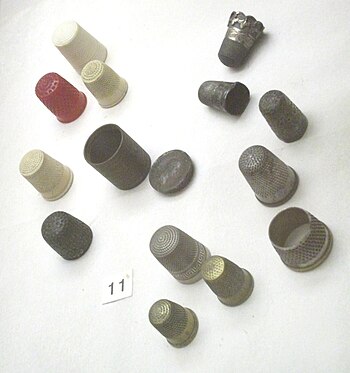Last time we asked: But what sort of things do people make thimbles from?
Well, modernly thimbles are made of all sorts of metal, ceramics, glass, plastic, leather, wood, ivory and bone, and combinations of all of the above. Eliminating the obviously non-historically accurate items like plastic takes us back to looking for something practical, available and affordable.
When I started making fibulae in quantity I needed something to protect my thumb from the wire. I grabbed a piece of thick leather and some duct tape, and essentially made a large thimble. Modernly there are still some types of thimbles that are made of leather. Doing a web search for leather thimbles will bring up dozens of different types, some of which include a small metal plate for even more protection. The big problem with leather thimbles is that they wear out much more quickly than metal ones and the chance that they will survive archaeologically in damp climates is slim.
Wood and bone thimbles would have been almost equally easy to make as leather ones, and just as easily lost in the archaeological record.
And this was where I hit a very annoying research wall. I own three books devoted completely to thimbles, one to sewing equipment, and one to The Medieval Household (MOL), and then there are also a couple of websites. I was recently pouring through my books on thimbles, trying to see if I could gather any sort of consensus from them. And I found a picture that made me cringe. It was a picture of “Leather thimbles from Mongolia”. Now I suppose if your definition of a thimble is “anything used to protect a finger” then it would be OK (remember this would include gloves). But the picture showed leather thumb rings that are used for shooting archery. The rest of the book was all sewing related thimbles. Sigh.
And then I went looking for a picture of the Han Dynasty thimble that I see widely reported, but with no pictures. I found one picture of a “thimble” that was found in Turkey that is supposed to “look just like” the Han Dynasty thimble. It was an archer’s thumb ring. So now I am questioning the whole assessment of some of the early thimbles. The websites and the books almost all use identical words. They seem to all suffer from what I would call “academic incest”. Someone wrote something, and everyone else just copied it, without checking to see if it was correct or not.
To say that I was annoyed, was an understatement. SOMEONE out there must have done a creditable job of studying thimbles! And then I remembered that I have one other book – “Findings – The Material Culture of Needlework and Sewing” by Mary C. Beaudry. Is it perfect? No. A lot of the comments were a bit ethnocentric for my taste, but the archaeology is solid, and that is what I needed.
So let’s go back to the reason for thimbles: Needles. The first steel needles were invented by the Chinese, for sewing fine silk, and these needles arrived in the Middle East in about the first century BC. Archaeology tells us that the Chinese were using metal needle rings by at least the second century AD. Most of these “rings” were made in the flat, and not soldered. This made them easily adjustable to any size of finger (think of the expandable rings that you can buy at flea markets).
Next time: Thimble Rings

